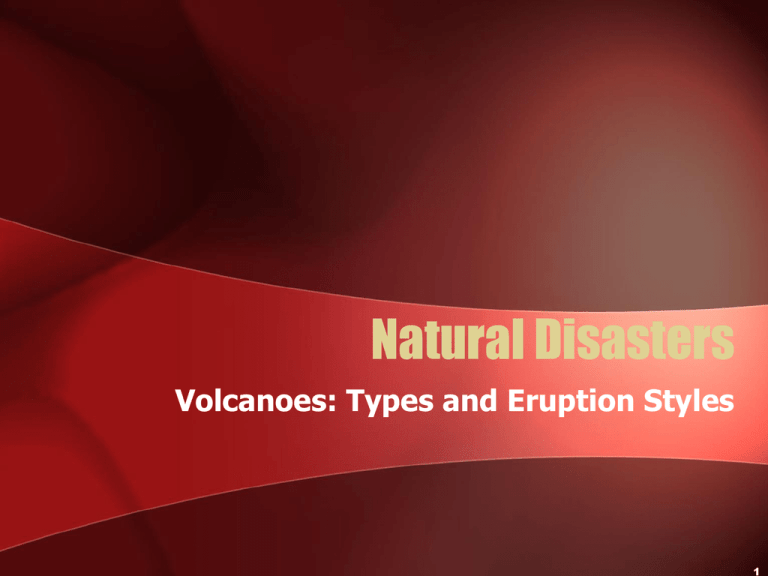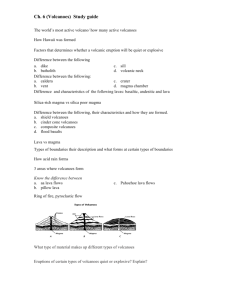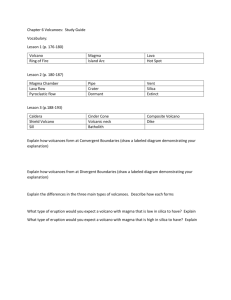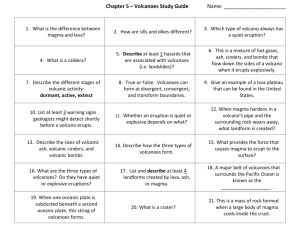Natural Disasters
advertisement

Natural Disasters Volcanoes: Types and Eruption Styles 1 Magma Review Basalt Andesite Rhyolite Magma Type Basalt Andesite Rhyolite SiO2 45-55% 55-65% 65-75% Viscosity Low Intermediate High Gas content Low Intermediate High Temperature 1000-1200°C 800-1000°C 650-800°C Types of Volcanoes Basaltic Volcanoes Shield volcanoes Cinder cones Andesitic Volcanoes stratovolcanoes Rhyolitic Volcanoes Lava domes calderas Basaltic Volcanoes Shield Volcanoes • Large, broad gentle slopes – resembles a “warrior’s shield” • Fluid basalt able to travel great distance • Low volatile (gas) content – generally non-explosive Shield Examples Mauna Loa (largest volcano) Hawaiian Islands • “Big Island” – Mauna Loa, Kilauea, and Mauna Kea Basaltic volcanoes Cinder Cones • • • • Small size, steep slope Erupt when magma encounters groundwater Single eruptive period (months to few years) Built up by loose cinders around small crater Cinder Cone Examples Cima Volcanic Field Amboy Crater California Cinder Cones Red Hill Andesitic Volcanoes Stratovolcanoes • • • • • Alternating layers of lava, debris, and ash Moderate volume and size Moderate to high volatile content Violently explosive Erupts repeatedly Stratovolcano Examples Mt. Hood Mt. Rainier Cascade Ranges Mt. Lassen Rhyolitic Volcanoes Lava Domes • Rough dome with many spines • Very high viscosity – magma does not travel far • Low volatile (gas) content Lava Domes Examples Mono Craters Panum Crater Central California Wilson Butte Rhyolitic Volcanoes Giant Continental Calderas • Circular, enclosed depressions • Typically filled with water to form lakes • Result from collapse volcanic structure – Due to underlying emptying of magma Continental Caldera Example Crater Lake, Oregon Yellowstone National Park Explosive Eruption Styles Hawaiian Phreatomagmatic Strombolian Vulcanian Pelean Plinian Hawaiian • Low-viscosity, fluid basalt • Non-explosive Phreatic & Phreatomagmatic • Hot magma comes in contact with shallow groundwater • Water heats up and erupts steam, rock fragments, and magma • Violently explosive • Phreatic = no new magma on surface Strombolian • • • • Distinct blasts of magma Produce incandescent bombs Small tephra cone results Mildly explosive Vulcanian • • • • Sustained eruption of rock or viscous magma to several km Collapse to produce pyroclastic flow Widespread tephra fall Very explosive Pelean • Collapse of lava dome • Produce glowing avalanches (nuée ardentes) • Violently explosive Plinian • Sustained eruption columns up to 45 km • Produce widespread ash deposits • Collapse of column to pyroclastic flow • Violently explosive Eruption Warning: Volcanic Precursors • Active Volcano – Has shown activity in recorded history • Extinct Volcano – Has not shown any historic activity • Dormant Volcano – Has not shown activity in recorded history but shows evidence of activity in geologic past Long-Term Forecasting • Ancient studies help scientist assess hazards and risk posed by future volcanoes Short-Term Forecasting • Seismic waves • Magnetic field changes • Electrical Resistivity • Ground Deformation • Changes in groundwater • heat flow • Gas composition






